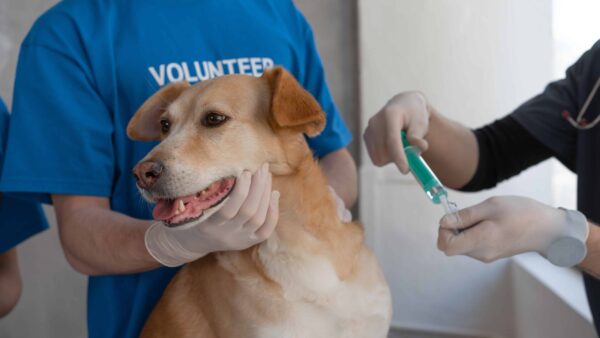Why Have you ever noticed your furry friend sticking to you more than usual and wondered, “Why do dogs get clingy suddenly?” Dogs are social animals, and they often show their affection to other people and pets by always wanting to interact with them.
Hence, if your dog starts showing a preference for only one person, it might indicate that something is amiss.
Several common reasons can explain this sudden behavior change. It might be that your dog is feeling anxious, he could be experiencing health issues, or perhaps there’s a change in their environment that’s causing them stress.
Understanding these triggers is crucial for addressing your pet’s newfound clinginess.
While dog clinginess can be annoying at times, there are effective strategies to help manage and reduce clinginess in dogs.
In this blog post, we have revealed all you need to know including tips on how you can help your dog become less clingy.
Without further Ado, let’s begin!
Why Do Dogs Get Clingy Suddenly? – 8 Common Reasons!

Dog clinginess doesn’t usually start overnight; several common triggers can prompt this behavior in your furry companion.
Below are the common reasons why your dog is becoming clingy suddenly:
1. Stress
Stress is a significant factor that can lead dogs to become clingy. Just like humans, things like moving to a new home, the arrival of a new pet or family member, or even loud noises like fireworks or thunderstorms can exacerbate stress in dogs.
In these situations, dogs often cling to their owners as a source of security and reassurance.
When dogs are stressed, they usually show some outward visible signs, and as a responsible pet owner, recognizing the signs of stress in your dog is crucial.
Below are the common signs of stress in dogs:
- Excessive barking
- Panting
- Yawning, drooling, and licking
- Hiding or escape behavior
- Abnormal shedding
- Trembling or shaking
- Refusing to eat
2. Health Issues
Health issues are another common reason why dogs may start to exhibit clingy behavior.
When a dog feels unwell or is in pain, they naturally seek comfort and security from their primary caregiver. This can manifest as your dog following you more closely than usual, being reluctant to leave your side, or showing a noticeable increase in seeking physical contact, such as nudging your hand or leaning against you.
Various health problems can trigger this behavior change, ranging from minor ailments like a stomach upset to more serious conditions like arthritis, dental pain, or even vision and hearing loss as they age.
Infections and chronic diseases such as diabetes or kidney issues can also affect a dog’s mood and behavior, leading them to become more dependent on their human companions.
3. Bad Habit
Bad habits can also lead to dogs becoming overly clingy. These habits may develop when a dog mimics the behavior of other dogs or when their owners inadvertently reinforce certain behaviors.
For example, if a dog notices that another dog gets extra attention for staying close to their owner, it might adopt the same behavior, hoping for the same outcome.
More commonly, owners can unintentionally encourage clinginess by rewarding their dogs with treats, affection, or verbal praise whenever they come close.
Over time, dogs learn to associate staying near their owner with positive rewards. This can lead to a behavioral pattern where they remain close by in anticipation of a treat or some form of attention, reinforcing the clingy behavior.
In such cases, the dogs aren’t necessarily clinging out of need or distress; instead, they are acting based on learned behaviors that have been positively reinforced.
4. Inadequate Socialization
Inadequate socialization can significantly contribute to clinginess in dogs.
Early socialization during puppyhood is crucial as it helps puppies learn to feel comfortable and confident in various situations.
This includes meeting different people, encountering various animals, and experiencing new environments.
Without this early exposure, dogs can become overly dependent on their owners because they feel anxious or fearful in unfamiliar situations.
Proper socialization teaches a dog to adapt and react confidently, reducing their need to seek constant reassurance from their owner. Thus, a well-socialized dog is generally more independent and less clingy.
5. Curiosity
This trait is noticeable in newborn puppies. They often want to learn from you. Consequently, they would follow you everywhere. Dogs tend to be closer to their owners when they are very young.
6. Boredom
When bored, one tends to gravitate towards known people.
Similarly, dogs do this as well. This means that your dog may find comfort in you when he is bored.
If there is no pet to relate with, your dog would be close to you. To alleviate this, make sure you get a lot of pets and toys in your house. This device helps your dog to get a lot of activity.
7. Age
Age plays a factor in a dog being clingy. Usually, puppies are very new to the world. They feel anxious and tend to be more afraid. As a result, they may be closer to their owners than usual.
Older dogs on the other hand usually develop problems with vision and hearing. Due to this deviation from normal health conditions, they might become clingy to their owners.
8. Clingy Dog Breeds
Some dog breeds are known to be more needy and clingy compared to others. These breeds are usually tagged “Velcro Dog Breeds“.
Some of the most common clingy breeds include Shih Tzus, Pomeranians, Border Collies, and French Bulldogs.
Working dogs are also usually trained to be dependent on their owner. Hence, if you own a working dog, he may become clingy over time.
How to Help Your Dog Become Less Clingy
To help your dog become less clingy, here are what you should do:
1. Gradual Separation: Gradual separation is essential for helping your dog become less clingy.
Start by leaving them alone for short periods, perhaps just a few minutes at a time, and gradually increase the duration over days or weeks.
This gradual approach allows your dog to become accustomed to being alone without experiencing overwhelming anxiety. During these alone times, provide distractions such as toys or treats to keep them occupied and reassure them that being alone is not a cause for concern.
By gradually building up their tolerance to separation, you can help your dog develop confidence and independence.
2. Provide Mental Stimulation: Mental stimulation is crucial for keeping your dog’s mind engaged and preventing clingy behavior.
Dogs, like humans, can get bored easily, leading them to seek constant attention.
Providing mental stimulation through activities such as puzzle toys, obedience training, or interactive games can keep them entertained and also tire them out mentally. Remember the popular saying “A tired dog is a happy dog”, and a happy dog is less likely to resort to clingy behavior out of boredom or frustration.
3. Encourage Independence: Teaching your dog to entertain themselves is key to reducing clinginess.
You can do this by providing them with chew toys, puzzle feeders, or interactive toys that they can enjoy on their own.
Designate a quiet area in your home where they can retreat to when they need some alone time. This could be a cozy bed or a crate where they feel safe and secure.
Encourage them to spend time in their designated space by rewarding calm behavior and gradually increasing the amount of time they spend there.
4. Increase Exercise: Regular exercise is vital for keeping dogs physically and mentally healthy.
Dogs that don’t get enough exercise may resort to clingy behavior as a way to burn off excess energy or seek stimulation.
Make sure your dog gets plenty of opportunities for physical activity through daily walks, playtime, or activities like fetch or agility training.
Not only does exercise tire them out physically, but it also helps reduce stress and anxiety, making them less likely to cling to you for comfort.
5. Desensitize Your Dog to Your Movements: Dogs can become clingy if they’re overly sensitive to your movements or actions.
To address this, gradually desensitize your dog to your comings and goings. Start by making small movements, such as picking up your keys or putting on your coat, without actually leaving.
Over time, gradually increase the intensity of your movements until your dog becomes desensitized and no longer associates them with you leaving.
This helps them understand that your movements are not always a signal for separation, reducing their anxiety and clingy behavior.
Conclusion.
Why do dogs get clingy suddenly? There are numerous reasons why your dog gets clingy suddenly, it may be due to stress, health issues, bad habits, inadequate socialization, curiosity, boredom, age, or breed tendencies.
It’s important to know the cause of your dog’s clinginess before taking the best course of action to address it.
Some of the ways you can help your dog become less clingy include providing mental stimulation, encouraging independence, increasing exercise, and desensitizing them to your movements. By implementing these strategies, you can help your furry friend feel more secure and content.








Leave a comment